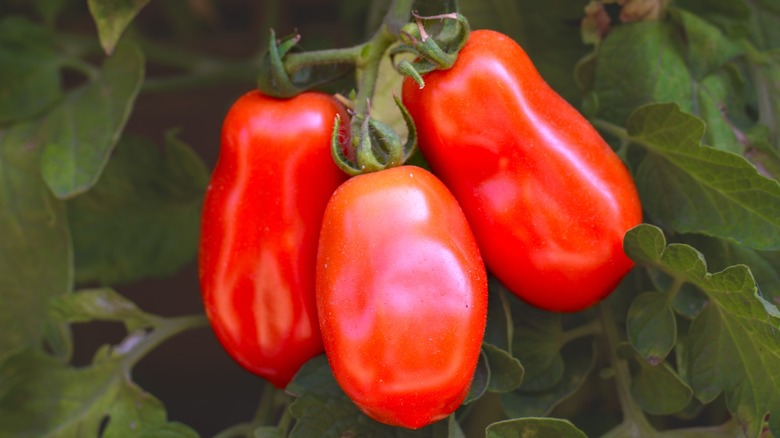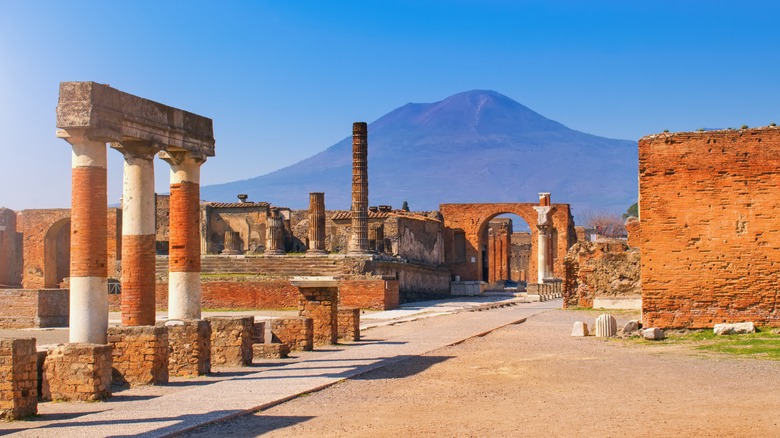The Volcanic Tomatoes That Are Revered For Authentic Neapolitan Pizza
Finding silver linings in the eruptions of Mount Vesuvius may sound outlandish, but with San Marzano tomatoes, that's exactly what the pizza-makers of Naples, Italy did. The land surrounding what is arguably the most famous volcano in the world has been enriched with phosphorus and potassium. There, the "pomodori di San Marzano" — meaning tomatoes of the San Marzano region — prosper along vines covering the ground of Italy's Sarno River Valley. Come summertime, these elongated plum tomatoes are ripe for the picking.
Such fruits are delicate in texture, red in color, and sugary in taste, with few seeds and little sourness. As a result, San Marzanos are part of a very small group of tomatoes that Neapolitan pizza-makers consider high-quality enough to grace their pies. Additionally, this variety enjoys a Protected Designation of Origin status, which requires them to be grown in Vesuvian soil. Still, authentic specimens, foreign relatives, and even knock-offs can be found across the globe — whether you're making Neapolitan pizza or just marinara sauce. So, if you're shopping and want to get the real stuff, keep an eye out for the P.D.O. sticker (and its accompanying high price tag).
Though questionable, San Marzano tomato seeds potentially came to Naples in the late 18th century, as a gift from the Viceroyalty of Peru to the Neapolitan King. At first, however, the locals suspected tomatoes were poisonous due to their relation to deadly nightshade. It took a near-famine to get the working class to reexamine this belief.
How did San Marzanos get added to Neapolitan pizza?
Similar to San Marzano tomatoes, the Neapolitan pizza benefits from a special Designation of Controlled Origin. In that spirit, the True Neapolitan Pizza Association has decreed that this dish must be circular, no more than 13 inches in diameter, with a raised edge. It should also feature thin, delicate dough (a mix of flour, salt, water, and yeast) that is kneaded, fermented, shaped, and matured under precise, traditional circumstances. Afterward, that dough forms the base of the pie, which is topped with local ingredients such as basil, cheese, extra virgin olive oil, and tomatoes — all of which is briefly cooked inside a wood-fired oven. Pizza-making families in Naples have known this process for generations.
However, pizza wasn't always like that, even in Naples itself. Before pizza was invented there in the 18th century, Arabic immigrants introduced the city to flatbreads. So, in the 1700s when a food shortage afflicted the poor especially hard, working-class Neapolitans dared to add the supposedly toxic tomato to their pita. The result was delicious, not dangerous, and the dish became a local celebrity. Among the tomatoes on hand was, of course, the San Marzano. Later, when a D.O.C. was bestowed upon this dish, it was decided San Marzano tomatoes must be used in order for the pizza to qualify as Neapolitan.
Why grow in Vesuvian soil?
The fact that chefs must use San Marzano tomatoes grown in Vesuvian soil to make genuine Neapolitan pizza is great for Naples' economy. There's more to it than that, though. The phosphorus-and-potassium-rich earth helps those tomatoes reach their full potential, giving them a sweet, pronounced flavor. In fact, volcanoes in general can spread various nutrients – including iron and magnesium — across nearby lands. Precipitation and the like then suffuses that ash into the ground. This effect can be observed in many places, such as Hawaii, where explosions hundreds of years ago made the cultivation of sweet potatoes and taro root a culturally significant development.
So, while Italy typically features limestone not ideal for farming, Mount Vesuvius has made its surroundings quite fertile. This includes ancient eruptions as far back as 35,000 years ago and the infamous Pompeii incident that took place almost two millennia from the present day. When the volcano acted up again in 1944, that renewed much of what had been depleted over the centuries, and thus, San Marzano growth is still going strong today.


